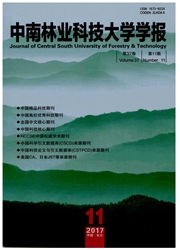

 中文摘要:
中文摘要:
依据木粉的目数和形态将其应用于不同材料领域可产生许多新特性的高附加值产品。在试验过程中以落叶松锯屑为加工原料,根据理论分析和试验结果,确定出了不同目数的木粉与木材细胞裂解间的关系及与加工工艺间的关系。试验结果表明,传统木粉机生产的木粉颗粒主要呈棒状,木屑颗粒的断裂主要是由于加工系统供给的能量大于纤维间的结合力,管胞间发生径向剥离并使颗粒的长径比随着颗粒的径向断裂逐渐减小;超细木粉机提供的能量使纤丝间发生位错产生滑移导致木材细胞横向结构破坏,木粉粒径更小。并将不同目数的木粉与加工时间、加工刀具和加工后得到的样品进行分析研究,并对木粉形态和粒径大小进行显微观测为针叶材管胞的破胞和今后纳米木粉的研究提供了意义重大的试验数据和理论支持。
 英文摘要:
英文摘要:
According to wood powder's mesh size and morphology, they are applied in different materials fields and can produce a lot of high value-added products with many new characteristics. In the course of the experiments, with larch sawdust as the raw materials, based on the theoretical analysis and experimental results, the relationship among the wood powder with different meshes, the wood cell lysis and the processing technology were determined. The test results prove that the wood particles produced by traditional wood powder machine primarily showed a rod shape, the fracture of sawdust particles is mainly attributable to the energy of processing system supply being more than the binding force between fibers and to the radial separation among tracheids, which made the particle aspect ratio gradually decreased with radial fracture; The energy that super fine wood powder machine provided made the interfibrillar to be dislocation and slippage and resulted in that the lateral structure destruction of the wood cell, thus the wood powder particle size was smaller. The relations between wood powder with different meshes and machining time, machining tool and the processed sample of different mesh size of wood powder were analyzed and the wood powder morphology and particle size were observed with microscope. This provides great significance test data and theoretical support for softwood tracheids' broken-cell and future producing nano wood powder.
 同期刊论文项目
同期刊论文项目
 同项目期刊论文
同项目期刊论文
 期刊信息
期刊信息
